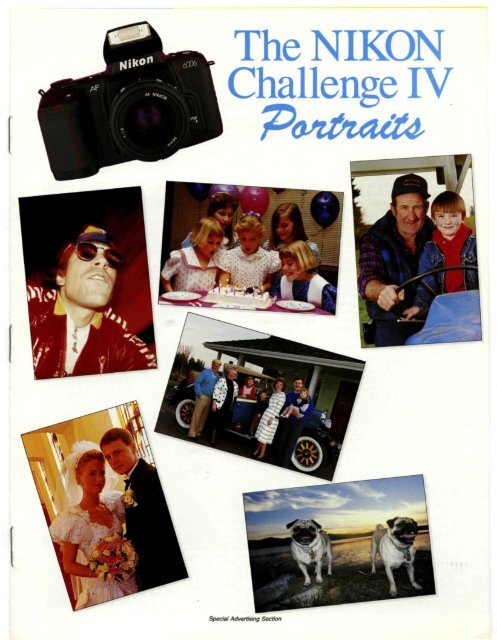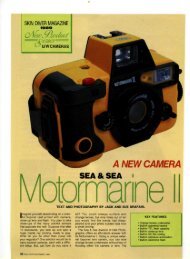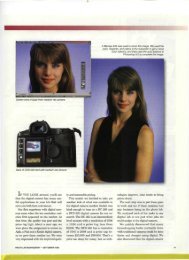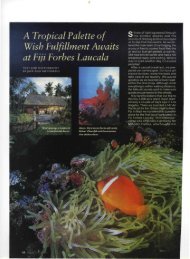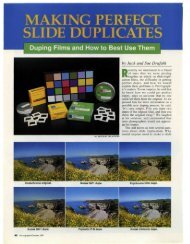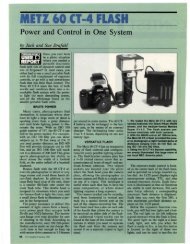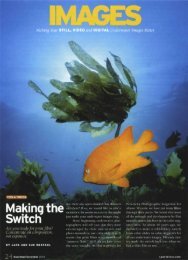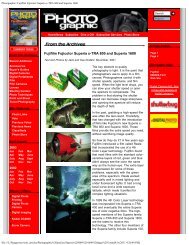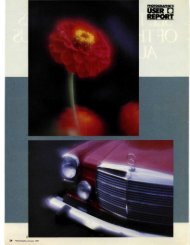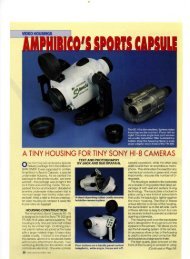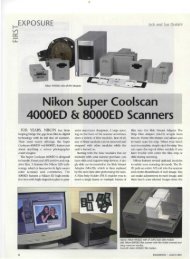Nikon Challenge 4 - Jack and Sue Drafahl
Nikon Challenge 4 - Jack and Sue Drafahl
Nikon Challenge 4 - Jack and Sue Drafahl
You also want an ePaper? Increase the reach of your titles
YUMPU automatically turns print PDFs into web optimized ePapers that Google loves.
The NIKON<br />
<strong>Challenge</strong> IV<br />
Special Advertising Section
AUTO MATRIX BALANCED FILL-FLASH,<br />
LONG EXPOSURE & REAR-CURTAIN<br />
SYNC WITH THE NIKON N6006<br />
Sophisticated images don't necessarily<br />
require lots of additional<br />
accessory equipment. The image<br />
shown here, for example, was made<br />
with a <strong>Nikon</strong> N6006 mounted to the<br />
h<strong>and</strong>lebars of a moving bike. The only<br />
other equipment needed for the shot<br />
was an air-bulb remote release <strong>and</strong> a<br />
Bogen Superclamp (which attached the<br />
camera to the h<strong>and</strong>lebars).<br />
Many SLRs have built-in flash units,<br />
ideal for snapshots. What separates the<br />
N6006 from the rest of the pack is that<br />
its powerful flash can be used in a variety<br />
of creative flash modes, including<br />
rear-curtain sync, in which the flash<br />
fires at the end of the exposure, rather<br />
than at the start. If you make a long exposure<br />
of a moving subject, <strong>and</strong> use<br />
front-curtain flash sync, the flash will<br />
fire when the camera shutter opens,<br />
then the long existing-light exposure is<br />
made. Thus, ghost-image "speed<br />
streaks" produced by the subject's<br />
movement appear to precede the subject<br />
in the photo. With rear-curtain<br />
sync, the long existing-light exposure is<br />
made first, <strong>and</strong> the flash fires just before<br />
the camera shutter closes. Thus,<br />
the ghostly speed streaks follow the<br />
subject—a very natural <strong>and</strong> pleasing<br />
visual effect.<br />
To make this shot, the photographer<br />
set the <strong>Nikon</strong> N6006 camera (with AF<br />
Nikkor 20mm f/2.8 superwide-angle<br />
lens*) for Programmed AE, Auto Balanced<br />
Fill-Flash, Matrix metering, <strong>and</strong><br />
Autofocus, along with Rear-Curtain<br />
Sync (by pressing a few buttons); then<br />
clamped the camera to the bicycle's<br />
* The N6006's built-in flash coverage is adequate<br />
for focal lengths as wide as 28mm; because<br />
the subject was centered in the frame,<br />
full illumination of the edges of the scene was<br />
not necessary.)<br />
CAMERA: <strong>Nikon</strong> N6006<br />
LENS: 20mm f/2.8 AF Nikkor<br />
FLASH: Built-in<br />
EXPOSURE MODE: Program AE<br />
METERING MODE: Matrix<br />
FLASH MODE: Rear-curtain sync<br />
EXPOSURE: 15 seconds at f/5.6<br />
EXPOSURE COMPENSATION: 0<br />
FLASH COMPENSATION: 0<br />
FILM: Kodachrome 200<br />
<strong>Nikon</strong> N6006 with<br />
20mm AF Nikkor lens<br />
Camera body attached<br />
to left h<strong>and</strong>lebar<br />
15-second exposure made with N6006's built-in flash in rear-curtain sync.<br />
h<strong>and</strong>lebars using a Bogen Superclamp,<br />
<strong>and</strong> attached an air-release cable. He<br />
then rode down New York City's 7th<br />
Avenue late at night, <strong>and</strong> squeezed the<br />
release bulb to fire the shutter. The<br />
N6006 automatically did the rest, <strong>and</strong><br />
Special Advertising Section<br />
recorded the effective image on Kodachrome<br />
200 film.<br />
You would think this type of photography<br />
would be hit-or-miss, but the<br />
results were predictable <strong>and</strong> intriguing,<br />
frame after frame!<br />
D
The NIKON<br />
<strong>Challenge</strong> IV<br />
GROUP PORTRAIT USING MULTIPLE<br />
SB-24 NIKON SPEEDLIGHTS WITH<br />
BOUNCE FLASH AND AUTOFOCUS<br />
Photographing children is always<br />
difficult. Following focus, readjusting<br />
the lighting, <strong>and</strong> resetting<br />
the exposure as the subjects move from<br />
one area to another tend to distract<br />
your attention from the composition<br />
<strong>and</strong> the subject's expression.<br />
The new <strong>and</strong> advanced <strong>Nikon</strong><br />
N8008S camera <strong>and</strong> SB-24 AF Speedlight<br />
flash unit will automatically h<strong>and</strong>le<br />
all the technical aspects of shooting<br />
a moving subject. All you need do is<br />
compose the scene through the brightscreen<br />
viewfinder, <strong>and</strong> wait for that<br />
perfect moment to take the shot.<br />
For this shot, two SB-24 AF Speedlights<br />
were attached to a light st<strong>and</strong><br />
<strong>and</strong> directed into an umbrella reflector.<br />
One SB-24 was attached to the camera<br />
via the <strong>Nikon</strong> SC-17 TTL flash cord,<br />
<strong>and</strong> the second was connected to the<br />
first with the SC-18 flash cord. The primary<br />
unit was set to TTL flash, with<br />
no flash compensation selected. Each<br />
power zoom head was manually set to<br />
24mm so that the flash beams would<br />
evenly fill the umbrella. The party <strong>and</strong><br />
cake were placed at one end of the table,<br />
<strong>and</strong> the photographer was at the<br />
other end. Image size <strong>and</strong> compositional<br />
cropping were accomplished by<br />
28-S5mm _^<br />
zoom lens<br />
N8008S —><br />
zooming the 28-85mm f/3.5-4.5 AF<br />
Nikkor zoom lens. An aperture off/5.6<br />
was used so that the flash recycle time<br />
would be rapid <strong>and</strong> the background<br />
would be thrown slightly out of focus.<br />
Umbrella bounce flash was selected to<br />
prevent one girl from casting a shadow<br />
on the next. The bounce flash elimi-<br />
CAMERA: <strong>Nikon</strong> N8008S<br />
LENS: 28-85mm f/3.5-4.5 AF Nikkor<br />
FLASH: Two SB-24 AF Speedlights,<br />
with SC-17 <strong>and</strong> SC-18 TTL cords<br />
EXPOSURE MODE:<br />
Aperture-Priority AE<br />
METERING MODE: Matrix<br />
FLASH MODE: TTL<br />
FOCUS MODE: Auto C mode<br />
MOTOR DRIVE: Continuous<br />
EXPOSURE: VM at f/5.6<br />
EXPOSURE COMPENSATION: 0<br />
FLASH COMPENSATION: 0<br />
FILM: Ektapress 100<br />
nated this problem <strong>and</strong> made the scene<br />
more natural-looking as well. For a different<br />
lighting effect, the light could be<br />
bounced off a wall or ceiling.<br />
The NSOOSS's autofocus capability<br />
automatically kept focus as the children<br />
moved back <strong>and</strong> forth within the<br />
scene.<br />
D<br />
Multiple-flash bounce portrait using SB-24s <strong>and</strong> continuous autofocus with the N800SS.<br />
Special Advertising Section
he NIKON<br />
rtallenge IV<br />
WILDLIFE PORTRAITS USING SPOT<br />
METERING AND THE 80-200mm f/2.8<br />
AF ZOOM NIKKOR LENS<br />
Animal portraits, whether they are<br />
made at the zoo or in the wild,<br />
are difficult to make with slow<br />
zoom lenses. A fast maximum aperture<br />
lets the photographer shoot in dim<br />
light, with slow-speed, fine-grain films.<br />
A fast maximum aperture also allows<br />
the photographer, when shooting with<br />
the lens wide-open, to blur background<br />
details, thus focusing emphasis on the<br />
main subject.<br />
The 80-200mm f/2.8 AF Zoom Nikkor<br />
is, quite possibly, the ideal portrait<br />
lens, whether your subjects are people<br />
or animals. This lens's range of focal<br />
lengths (80mm to 200mm) encompasses<br />
all of the traditional portrait focal<br />
lengths—85mm, 105mm, 135mm,<br />
180mm, <strong>and</strong> 200mm. Additionally, the<br />
80-200mmf/2.8 AFZoom Nikkor possesses<br />
an ultra-fast maximum aperture<br />
of f/2.8, meaning that at any focal<br />
length, at a suitable camera-to-subject<br />
80mm<br />
CAMERA: <strong>Nikon</strong> F4S<br />
LENS: 80-200mm f/2.8 AF Zoom<br />
Nikkor<br />
EXPOSURE MODE:<br />
Aperture-Priority AE<br />
METERING MODE: Spot<br />
FOCUS MODE: Auto S mode<br />
MOTOR DRIVE: Single frame<br />
EXPOSURE: f/2.8 to f/5.6; shutter<br />
speed varied accordingly<br />
EXPOSURE COMPENSATION: 0<br />
FILM: Kodak Ektachrome 100<br />
Plus Professional<br />
200mm<br />
distance, you can blur the background,<br />
while keeping the subject razor-sharp.<br />
The 80-200mm f/2.8 AF Zoom Nikkor<br />
lens incorporates special elements<br />
made of extra-low dispersion glass,<br />
which all but eliminate chromatic aberrations<br />
that occur at telephoto focal<br />
lengths.<br />
An additional benefit of the 80-<br />
200mm f/2.8 AF Zoom Nikkor lens is<br />
that it has excellent close-focusing capabilities.<br />
In macro-focusing mode, the<br />
lens can focus down to a distance of 4.9<br />
feet for a reproduction ratio of 1:5.9<br />
(ideal for portraits of animals).<br />
All of the animal portraits shown<br />
here were made with the 80-200mm<br />
AF Zoom Nikkor lens <strong>and</strong> a <strong>Nikon</strong><br />
F4S camera set for Aperture-Priority<br />
AE. The F4S's depth-of-field preview<br />
Special Advertising Section<br />
135mm<br />
enabled the photographer to determine<br />
just which aperture would provide the<br />
desired effect; the camera's Aperture-<br />
Priority AE mode permitted him to set<br />
it, while still enjoying the shooting freedom<br />
<strong>and</strong> speed of automatic exposure<br />
control.<br />
D<br />
/<br />
\
WIDE-ANGLE AUTOMATIC MATRIX<br />
BALANCED FILL-FLASH WITH THE<br />
NIKON N6006<br />
Wide-angle flash is a problem,<br />
usually. Especially with builtin<br />
flash units, the flash doesn't<br />
cover a wide enough area to permit<br />
shooting evenly lit images with wideangle<br />
lenses. The <strong>Nikon</strong> N6006's builtin<br />
flash, however, covers a wide enough<br />
angle to permit shooting evenly lit photographs<br />
with lenses as wide as the AF<br />
Nikkor 28mm f/2.8 lens used here.<br />
<strong>Nikon</strong>'s N6006 offers built-in flash<br />
with Automatic Balanced Fill-Flash,<br />
through which the exposure is perfectly<br />
<strong>and</strong> automatically balanced with ambient<br />
light. This feature, along with the<br />
built-in unit's wide angle of coverage,<br />
made this photograph possible—automatically.<br />
The camera was set for Programmed<br />
auto-exposure, Matrix Metering,<br />
Automatic Balanced Fill-Flash,<br />
<strong>and</strong> Autofocus. Then all the photographer<br />
had to do was compose, <strong>and</strong><br />
shoot.<br />
As the sky grew darker with every<br />
passing minute, the camera's highly<br />
sensitive metering system compensated<br />
accordingly, producing frame after<br />
frame with perfectly balanced fill-flash.<br />
In addition to providing balance be-<br />
CAMERA: <strong>Nikon</strong> N6006<br />
LENS: 28mm f/2.8 AF Nikkor<br />
FLASH: Built-in<br />
EXPOSURE MODE: Program AE<br />
METERING MODE: Matrix<br />
FLASH MODE: Auto Balanced<br />
Fill-Flash<br />
FOCUS MODE: Auto S mode<br />
MOTOR DRIVE: Single frame<br />
EXPOSURE: Vao at f/5.6<br />
FLASH COMPENSATION: 0<br />
EXPOSURE COMPENSATION: 0<br />
FILM: Kodachrome 64<br />
<strong>Nikon</strong> N6006 camera<br />
with 28mm AF Nikkor lens<br />
tween flashlit subjects <strong>and</strong> existing-lit<br />
backgrounds automatically, the N6006<br />
permits the photographer to adjust the<br />
flash-to-existing-light ratio (within a<br />
range of one stop over to three stops<br />
under the st<strong>and</strong>ard ratio, in '/j-stop increments)<br />
as desired, by setting the<br />
chosen degree of compensation. To<br />
darken the background <strong>and</strong> lighten the<br />
foreground subject, you can set the<br />
camera compensation to -1 <strong>and</strong> the<br />
flash compensation to +1, for example.<br />
This versatility is provided by no<br />
other camera's built-in flash unit, <strong>and</strong><br />
by few accessory flash units. D<br />
Daylight-balanced automatic fill-flash.<br />
Special Advertising Section
The NIKON<br />
<strong>Challenge</strong> IV<br />
MULTIPLE AUTOMATIC MATRIX<br />
BALANCED FILL-FLASH WITH THE<br />
N8008S<br />
CAMERA: <strong>Nikon</strong> N8008S<br />
LENS: 75-300mm AF Nikkor<br />
f/4.5-5.6<br />
FLASH: Two SB-24 AF Speedlights,<br />
connected with SC-17 <strong>and</strong> SC-19<br />
flash cords<br />
EXPOSURE MODE: Program AE<br />
METERING MODE: Matrix<br />
FLASH MODE: TTL<br />
FOCUS MODE: Auto S mode<br />
MOTOR DRIVE: Continuous<br />
EXPOSURE: Vm at f/8<br />
FLASH COMPENSATION: 0<br />
EXPOSURE COMPENSATION: 0<br />
FILM: Kodak Ektapress 100<br />
One of the main advantages of <strong>Nikon</strong>'s<br />
Matrix Balanced Fill-<br />
Flash is that it works with multiple<br />
flash units, thus allowing the photographer<br />
to produce professionally lit<br />
portraits with the ease of full TTL exposure<br />
automation.<br />
With the advanced new <strong>Nikon</strong><br />
N8008S camera, two SB-24 AF Speedlight<br />
flash units, <strong>and</strong> the appropriate<br />
<strong>Nikon</strong> dedicated TTL flash cords, you<br />
can let the camera <strong>and</strong> flash automatically<br />
take care of the technical details<br />
of the shot, so all you need do is compose,<br />
<strong>and</strong> watch in the bright viewfmder<br />
for that ideal expression.<br />
For this shot, an AF Nikkor 75-<br />
300mm zoom lens was mounted on the<br />
N8008S, <strong>and</strong> an SB-24 AF Speedlight<br />
was attached to the camera via the SC-<br />
17 flash cord. A second SB-24 was attached<br />
to the first using the SC-19 flash<br />
cord. The SB-24s were set to TTL<br />
flash, <strong>and</strong> all other functions were in<br />
their default modes. An assistant held<br />
one of the SB-24s just off camera <strong>and</strong><br />
the other at arm's length, <strong>and</strong> directed<br />
each so that flash shadows were minimized.<br />
The subjects were then asked to<br />
carry on as they discussed various aspects<br />
of farm life. They were advised<br />
that they could move about freely within<br />
the scene. Using the autofocus system<br />
of the N8008S <strong>and</strong> the zoom function<br />
of the lens <strong>and</strong> flash, the photographer<br />
was able to shoot various compositions<br />
of the scene with little effort,<br />
<strong>and</strong> great results.<br />
When the subjects moved, even<br />
slightly, the autofocus feature of the<br />
N8008S responded precisely <strong>and</strong> predictably,<br />
so that each frame of the couple<br />
is razor sharp. Also, the meter was<br />
set to Matrix mode to ensure that the<br />
flash-fill would be equally balanced<br />
with the daylight exposure. D<br />
Informal portraits made with two SB-24s<br />
<strong>and</strong> the N8008S.<br />
Special Advertising Section<br />
,^_75-300mm<br />
zoom lens
WEDDING PORTRAITS USING MULTIPLE<br />
SB-24 SPEEDLIGHTS<br />
Wedding photographers have<br />
long known that electronic<br />
flash is useful not only to provide<br />
enough lighting when the existing<br />
light isn't very bright, but also to provide<br />
good lighting when the existing<br />
light isn't very attractive. <strong>Nikon</strong>'s automatic<br />
TTL flash metering, even when<br />
more than one flash unit is used, makes<br />
such lighting easy <strong>and</strong> predictable.<br />
For these photos, two SB-24 AF<br />
Speedlights were used with a <strong>Nikon</strong><br />
F4S camera. The first flash was connected<br />
to the camera using the SC-17<br />
TTL cord; the second connected to the<br />
first using the SC-19 cord. An assistant<br />
held the first SB-24 just off camera,<br />
<strong>and</strong> the the second at arm's length. The<br />
primary SB-24 was set to rear-curtain<br />
sync so that a shutter speed slower<br />
than '/*) could be used (a shutter speed<br />
of Vis was indicated by the F4S's Ma-<br />
CAMERA: <strong>Nikon</strong> F4S<br />
LENS: 28-85mm f73.5-4.5 AF Nikkor<br />
FLASH: Two SB-24 AF Speedlights,<br />
with SC-17 <strong>and</strong> SC-19 TTL flash<br />
cords<br />
EXPOSURE MODE:<br />
Program AE<br />
METERING MODE: Matrix<br />
FLASH MODE: TTL, rear-curtain<br />
sync<br />
FOCUS MODE: Auto S mode<br />
MOTOR DRIVE: Single frame<br />
EXPOSURE: Vis at f/5.6<br />
EXPOSURE COMPENSATION: 0<br />
FLASH COMPENSATION: 0<br />
FILM: Fujicolor 400<br />
Professional HG<br />
trix metering system for the existing<br />
light). Because the existing-light <strong>and</strong><br />
flash exposures were balanced (automatically<br />
by the TTL flash metering),<br />
both photographer <strong>and</strong> wedding couple<br />
held very still during the exposures to<br />
ensure that there was no blurring due<br />
to subject or camera movement at such<br />
a slow shutter speed.<br />
Several variations of wedding portraits<br />
were produced. All of the images<br />
included a mix of lighting: filtered daylight<br />
coming through the stained-glass<br />
windows, tungsten lights from the<br />
church interior, <strong>and</strong> of course, the daylight-balanced<br />
flash of the SB-24s. In<br />
each case, the Matrix balanced fillflash<br />
capability of the F4S <strong>and</strong> SB-24<br />
AF Speedlights produced beautiful,<br />
perfectly exposed images. ffl<br />
Wedding portraits using<br />
the F4S, multiple SB-<br />
24s, Matrix balanced fillflash,<br />
<strong>and</strong> mixed lighting.<br />
The combination of<br />
such varied light<br />
sources, including flash,<br />
would have taken much<br />
time to calculate "the<br />
old fashioned way." Matrix<br />
balanced fill-flash<br />
makes the task completely<br />
automatic.<br />
Special Advertising Section
MULTIPLE SB-24 SPEEDLIGHTS FOR<br />
FILL-FLASH<br />
AND KEY-FLASH<br />
When shooting people shots outdoors,<br />
direct sunlight produces<br />
harsh shadows <strong>and</strong> squinting<br />
subjects. Open shade produces softer<br />
lighting <strong>and</strong> doesn't cause the subjects<br />
to squint, but the light is blue—not attractive<br />
for people pictures. Also, open<br />
shade produces an unflattering lighting<br />
pattern on faces, with shadowy, hollowed-out<br />
eye sockets, <strong>and</strong> exaggerated<br />
shadows under the nose, lips, <strong>and</strong> chin<br />
of the subject.<br />
By using <strong>Nikon</strong> SB-24 AF Speedlight<br />
flash units in conjunction with<br />
outdoor lighting, most of these problems<br />
can be overcome, with beautiful<br />
portraits the result. For this photograph<br />
of a three-generation family, the<br />
members were gathered together in<br />
front of their antique car, which was<br />
parked in front of the family home.<br />
The shot was taken in late afternoon,<br />
when the car <strong>and</strong> front of the home<br />
were in open shade. The ambient light<br />
still cast dark shadows, so the photographer<br />
used two SB-24 AF Speedlights<br />
to fill-in the shadows.<br />
One SB-24 was attached to the<br />
N8008S camera via the SC-17 TTL<br />
flash cord, <strong>and</strong> a second SB-24 flash<br />
was then attached to the first via the<br />
i<br />
CAMERA: <strong>Nikon</strong> N8008S<br />
LENS: 35-70mm f73.5-4.5 AF Nikkor<br />
FLASH: Two SB-24 AF Speedlights,<br />
with SC-17 <strong>and</strong> SC-19 TTL cords<br />
EXPOSURE MODE: Program AE<br />
METERING MODE: Matrix<br />
FLASH MODE: TTL<br />
FOCUS MODE: Auto S mode<br />
MOTOR DRIVE: Single frame<br />
EXPOSURE: Vi2s at f/8<br />
EXPOSURE COMPENSATION: 0<br />
FLASH COMPENSATION: 0, +1<br />
FILM: Kodak Ektapress 100<br />
SC-19 flash cord. Both SB-24s were set<br />
at the wide-angle position to produce<br />
the widest angle of coverage. An assistant<br />
held both flash units, <strong>and</strong> angled<br />
them so they spread even coverage over<br />
the entire group. The N8008S <strong>and</strong> SB-<br />
24s then properly exposed the scene<br />
perfectly, automatically.<br />
Several variations of the three-generation<br />
portrait were produced, including<br />
the one shown here of gr<strong>and</strong>father, father,<br />
<strong>and</strong> son. The photographer<br />
moved the group to the front of the car,<br />
<strong>and</strong> input +1 flash compensation on<br />
the primary SB-24. The result is keyflash,<br />
wherein the ambient light becomes<br />
the fill light, <strong>and</strong> the SB-24s become<br />
the main light.<br />
ffl<br />
SB-24<br />
SB-24<br />
SC-19<br />
Special Advertising Section


